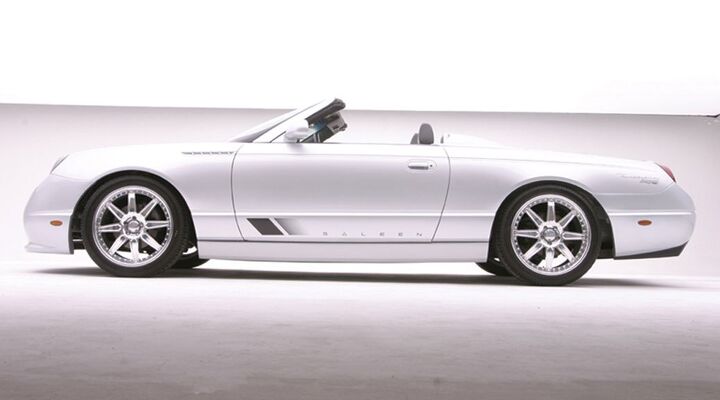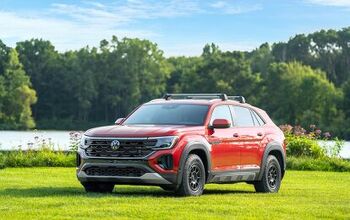Rare Rides: The 2002 Saleen Thunderbird Bonspeed Edition, One of One

The special takes on the early 2000s Ford Thunderbird just keep on coming! Our first Thunderbird edit came from Ford, in the 007 Special Edition made in conjunction with the fairly terrible James Bond film Die Another Day. More recently, we took a look at a Chip Foose creation ordered up by Ford called the Speedbird.
In a similar vein, today’s Rare Ride comes from Ford customizer Saleen in conjunction with Californian wheel firm Bonspeed. Are you ready for retro?
Steve Saleen’s take on the new Thunderbird was announced on November 5th, 2002, during the first model year of the 11th generation T-Bird. Saleen was approached (like Foose the following year) to create a specialty Thunderbird for display at the Ford stand at SEMA in 2002. Saleen was happy to accept Ford’s money and create a design but brought in another party: Bonspeed. Bonspeed is a designer primarily of wheels but also creates other various aftermarket accessories and gauges. Bonspeed was contracted to provide styling input and the wheels on the Saleen Thunderbird.
Designers from both companies took the stock Thunderbird in a hot-rod direction. The front end received a three-inch nose extension and a new grille forged in aluminum. Saleen ditched the standard convertible setup and turned the Bonspeed into a speedster. The roofless design featured a weird split rear spoiler and rollover hoops behind the seats. A hard cover replaced the tonneau of the standard car. Other changes outside included a hidden exhaust, fender vents, and a steeper rake on the windshield. The prototype was painted in a unique silver paint that looked like any other silver.
Inside there were Saleen gauges, sports seats, custom headrests, contrasting grey stitching, and leather-covered surfaces on the center console, lower dash areas, and the panels behind the seats. The leather was higher quality than standard, a “brushed metal tone” style, and there were luxurious deep-pile carpets.
Unlike the previously featured Speedbird, Saleen’s modifications included changes to the engine, suspension, and brakes. The 3.9-liter Jaguar V8 had a Saleen Series IV supercharger attached. It was paired with a unique inlet, intake manifold, and intercooler. Saleen also replaced the fuel injection system and implemented a Saleen-branded engine management program. These changes took the 3.9 from the stock output of 280 horses to 365, and 390 lb-ft of torque. The five-speed automatic was standard Ford fare, but the Bonspeed would also offer a six-speed Saleen manual.
The “would” is there because Saleen and Bonspeed were most pleased with their work on the Thunderbird. At the car’s announcement the day SEMA began, Saleen announced the Bonspeed would enter production. Production versions were to have a full Saleen Racecraft suspension, and Brembo brakes as well.
Saleen planned to build the Bonspeed Edition immediately at its factory in California, given the tremendous interest shown in the car before its debut. The company was eager to show off a greater diversity in what it could design, and produce a car more attainable than its S7 supercar. Orders were taken, deposits collected, and deliveries planned in spring 2003. The asking price was in the $70,000 range.
But the Bonspeed never went to production, in what must’ve been the first-ever Saleen failure. News and details of the car quickly evaporated, and only the SEMA prototype was ever made. The silver car has accumulated 20,000 miles in the ensuing years and goes to auction in October at Mecum in Las Vegas.
[Images: Saleen, Bonspeed]

Interested in lots of cars and their various historical contexts. Started writing articles for TTAC in late 2016, when my first posts were QOTDs. From there I started a few new series like Rare Rides, Buy/Drive/Burn, Abandoned History, and most recently Rare Rides Icons. Operating from a home base in Cincinnati, Ohio, a relative auto journalist dead zone. Many of my articles are prompted by something I'll see on social media that sparks my interest and causes me to research. Finding articles and information from the early days of the internet and beyond that covers the little details lost to time: trim packages, color and wheel choices, interior fabrics. Beyond those, I'm fascinated by automotive industry experiments, both failures and successes. Lately I've taken an interest in AI, and generating "what if" type images for car models long dead. Reincarnating a modern Toyota Paseo, Lincoln Mark IX, or Isuzu Trooper through a text prompt is fun. Fun to post them on Twitter too, and watch people overreact. To that end, the social media I use most is Twitter, @CoreyLewis86. I also contribute pieces for Forbes Wheels and Forbes Home.
More by Corey Lewis
Latest Car Reviews
Read moreLatest Product Reviews
Read moreRecent Comments
- Lorenzo The unspoken killer is that batteries can't be repaired after a fender-bender and the cars are totaled by insurance companies. Very quickly, insurance premiums will be bigger than the the monthly payment, killing all sales. People will be snapping up all the clunkers Tim Healey can find.
- Lorenzo Massachusetts - with the start/finish line at the tip of Cape Cod.
- RHD Welcome to TTAH/K, also known as TTAUC (The truth about used cars). There is a hell of a lot of interesting auto news that does not make it to this website.
- Jkross22 EV makers are hosed. How much bigger is the EV market right now than it already is? Tesla is holding all the cards... existing customer base, no dealers to contend with, largest EV fleet and the only one with a reliable (although more crowded) charging network when you're on the road. They're also the most agile with pricing. I have no idea what BMW, Audi, H/K and Merc are thinking and their sales reflect that. Tesla isn't for me, but I see the appeal. They are the EV for people who really just want a Tesla, which is most EV customers. Rivian and Polestar and Lucid are all in trouble. They'll likely have to be acquired to survive. They probably know it too.
- Lorenzo The Renaissance Center was spearheaded by Henry Ford II to revitalize the Detroit waterfront. The round towers were a huge mistake, with inefficient floorplans. The space is largely unusable, and rental agents were having trouble renting it out.GM didn't know that, or do research, when they bought it. They just wanted to steal thunder from Ford by making it their new headquarters. Since they now own it, GM will need to tear down the "silver silos" as un-rentable, and take a financial bath.Somewhere, the ghost of Alfred P. Sloan is weeping.


































Comments
Join the conversation
Beauty is in the eye of the beholder and I always liked the 55 thru 57 T-Birds and the retro Bird was not that bad. I also didn't mind the 4 seater T-Birds.
Nothing anyone can do to make this turd of a car look good. Retro at it's absolute worst. I would love to ask the execs who gave it the green light what drugs they were on.